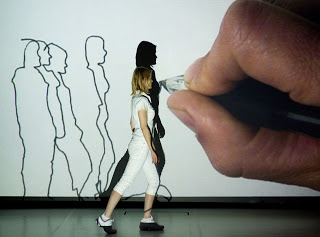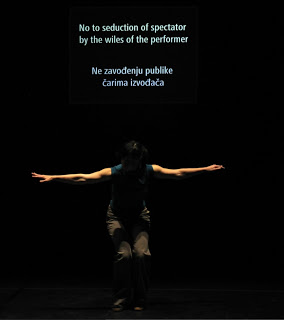After Trio A + Beginning – Curatorial Statement
January 06, 2012
By Mirna Zagar, Executive Director of The Dance Centre
 The invitation for Andrea Bozic to come to Vancouver and present her work came quite late, as our originally scheduled artist Ivana Muller had to temporarily put on hold all physical activity to attend to motherhood. While I was sorry our community wouldn’t be able to see Ivana’s work for a while, I didn’t hesitate for a second to call on Andrea.
The invitation for Andrea Bozic to come to Vancouver and present her work came quite late, as our originally scheduled artist Ivana Muller had to temporarily put on hold all physical activity to attend to motherhood. While I was sorry our community wouldn’t be able to see Ivana’s work for a while, I didn’t hesitate for a second to call on Andrea.
I have known Andrea since her days as a student. Croatian born, she earned her degree in Comparative Literature and English Language in Croatia, and for a couple of years assisted me with the Dance Week Festival as well as other international projects. She was just out of dance school at the time. Her genuine enthusiasm, curiosity, passion for the performing arts coupled with a keen sense of analytical observation and her high voltage energy stood out even then! It was not a surprise then to one day hear her desire to further pursue her interest in performing arts as a practicing artist. Holland was a natural move as we had developed extensive connections to the Dutch mime and contemporary dance scene. And – off she went. I followed her development with pride and joy from the time she entered the School for New Dance Development in Amsterdam, which she completed in 1999, and then to her graduation from the Dance Unlimited MFA program in movement research and new media at the Theatre School Amsterdam. Her works continued to reflect her broad interests and as a result she continued to work cross-disciplinarily including performance, installation and short film. Slowly but steadily she was moving up and her work was spreading internationally, attracting the support of one of Holland’s most notable production houses The Frascatti.
Moving forward to Springdance Festival 2009 (Holland’s key festival and launch pad for many a Dutch choreographer), I came across her and two other long-time acquaintances of mine: Emio Greco and Pieter Scholten – the renowned Dutch artistic duo who are at the helm of ICK (International Choreographic Arts Centre), an internationally acclaimed choreographic and dance research centre in Amsterdam. It was the premiere of the performance Beginning, Middle, End by artists Andrea Bozic, Madalina Dan and Michael Pinchbek. This was a commission by the Festival for a collaboration by three former participants from three different countries- the work’s title itself refers both to the structure and concept of the work and to the structure of the working process. It was at that time that Emio and Pieter invited Andrea to become the first artist in residence at the ICK. The motivation for their choice lay in a “strong connection paired with mutual curiosity and empathy”. The structure of the piece itself allowed the authors to retain some autonomy yet also to collaborate on a full-length work. I was quite intrigued and enjoyed the simplicity of this endeavor that at the same time put forward questions that each author has to face each time a work is in the making. It was quite brilliant, I thought, at the time. And still do.
Also interesting, was that each part retained a life of its own. The full-length piece was created out of 3 simple words: beginning, middle, and end—turning the words into both form and content. In the end it was the questions that mattered, and the continuing dialogue: What is beginning? What is ending? What is it like to be in the middle? How are a beginning, middle and end related and how do they interact?
Beginning as a performance is the staging of a negotiation. It’s a dialogue between video artist Julia Willms’ drawing hand and Andrea’s moving body; a dialogue which happens somewhere in between sketching, walking, painting and the ritual of the dance. Simply put: two people talking.
After Trio A is based on Yvonne Rainer’s minimal dance piece Trio A and the No Manifesto written alongside of it (reconsidered in 2008). For those not as familiar with dance history: Trio A reduced dance to its essentials and is considered one of the beginning of postmodern dance. Yvonne Rainer turned the then current conventions of dance and the perception of body upside down, saying “dance is hard to see”. After Trio A is not a re-staging of Trio A, but a dialogue with it. The audience is not excluded. On the contrary, it becomes very much part of the piece as audience members go through the process in which watching becomes learning, learning becomes virtuosity, task-like activity becomes a dance, knowledge becomes power, history becomes present, body becomes political, the non-spectacular becomes strangely spectacular.
This work was commissioned by the organization of notable Cover#2 who invited Andrea Bozic to remake of a piece by a choreographer of a previous generation. Andrea’s response to the challenge resulted in a dialogue with a master, where she asks two dancers to learn a part of the original Trio A phrase live on stage, without any previous knowledge of it. They do it in front of the audience, learning from a recording of the original piece played on a TV monitor, within the course of the hour.
Andrea collaborates regularly with video artist Julia Willms. Wilms has worked with prominent composers and choreographers such as Chris Haring of Liquid Loft, and has also presented her work at galleries in Vienna, New York, Ghent, Essen and London among others. Another of Andrea’s long time collaborators is Robert Pravda, who, having studied engineering at the University of Novi Sad (former Yugoslavia) dedicated himself to making music in experimental underground circles. In 2001 he started WEIM a workshop on electro-instrumental music, which transformed into the electronica improvisational ensemble RecPlay. During his studies in Holland, he concentrated on building instruments for multimedia performances and making algorithmic compositions for spatial sound and light installation. For his sound-light installation 5x5x5 he was awarded the visitor’s prize of Shell’s Young Artist award in 2002. He currently teaches a course on image and sound with Kasper van der Horst, works with research groups Interactive Sonice Spaces and Genius Loci, and teaches sound-design at the St. Joost Academy in Breda. He exhibits throughout Holland, Germany, Belgium.
Andrea’s works always propose unorthodox strategies of viewing and often deal with the nature of reality and its perception. What happens on the borders between spaces has always been of particular interest to myself in making curatorial choices and in observing dance. Specifically I am intrigued around the notion of time, as much as I am fascinated by the treatment of space; how then does our perception of these change through the movement of the body or the action afore us? Some artists have an exceptionally elaborate way of approaching these questions, some invent new vocabulary and syntax – Andrea is very perceptive in all of her approaches, her questions probe – yet it is amazing how it all suddenly appears effortless, the connections of the key stakeholders in the making of a performance becomes subtly but strongly immersed and intertwined, seamless and so simple, allowing us to enter her world as it unfolds before us. However it is far from simplistic! After all she explores and proposes possible responses to questions most appropriate for stage: Where am I? What can I see? In what physical, fictional, imaginary space am I? The stage is a place in which to look and a place of practice. The theatre being a permanent space for dialogue on liveness. This has been the driving force behind her work: she investigates the relationships between presence, intimacy, distance in a space configured by media as much as by our own perception of what unfolds before us. And, nothing she does diminishes our experience of the reality before us or the one we are left to form through our own experience of the reality we shared with the performer(s) and with our fellow audience members. In her works she becomes a maverick as she investigates the themes of makeable realities and the shifting boundaries and the relations between reality and its perception.
Having followed Andrea’s work from her very first steps through to her development into a mature accomplished theatre maker, I have been particularly taken by the way she involves new media: combing, juxtaposing, questioning, probing, and blurring the boundaries between film, video and choreography. I am thrilled to be able to present Andrea’s work to Dance Centre and PuSh Festival audiences. It is the type of work that opens the dialogue on what dance is today and what it will be tomorrow, reminding us how often great ideas come in small packages! There is nothing really small about any of this, as something that once said “No” to spectacle becomes spectacular in its own way as does After Trio A. Watching becomes learning, learning becomes virtuosity, task-like activity becomes a dance, knowledge becomes power, history becomes present, body becomes political, the non-spectacular becomes strangely spectacular.

